Strength Training is a Secret to Longevity
Strength training boosts a key longevity hormone more than aerobic exercise does – so we love ‘em both. No need to have a favorite.
Lost your password? Please enter your email address. You will receive a link to create a new password.
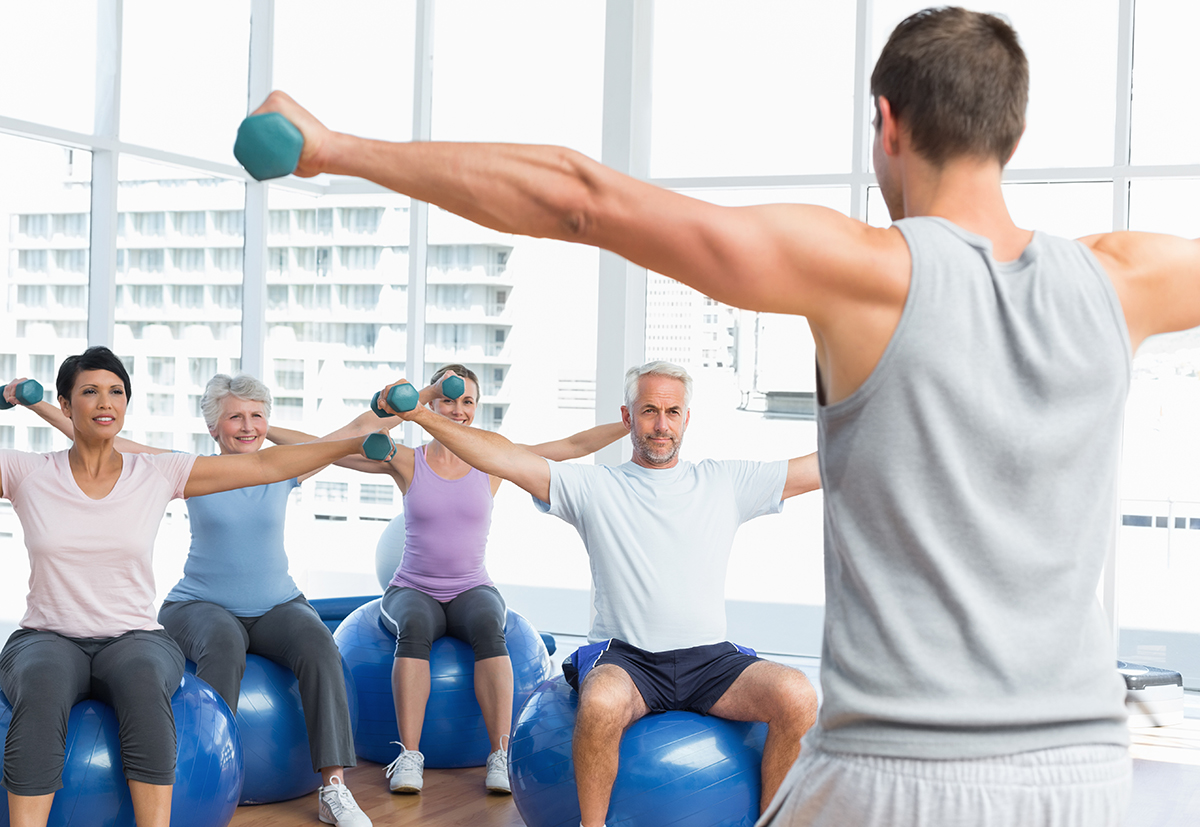
Strength training boosts a key longevity hormone more than aerobic exercise does – so we love ‘em both. No need to have a favorite.
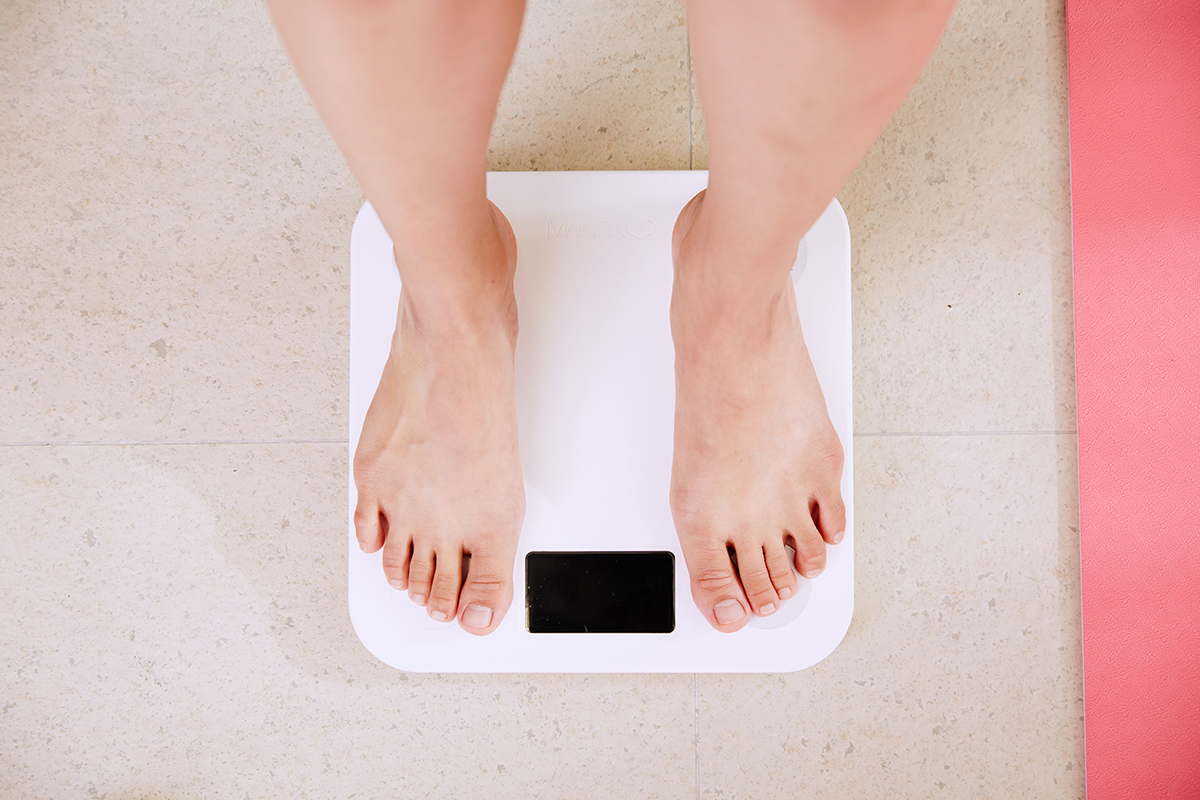
“I lost 10 pounds and vowed to keep them off, but no such luck. I’m so discouraged.”
“I reached my goal weight, then BOOM, I regained it once I stopped dieting.
“This is my 3rd time losing 40 pounds…”
If any of those stories sound familiar, you are not alone. Research suggests dieters tend to regain lost weight within five years, if not sooner. This includes many fitness exercisers and athletes who struggle to stay at a goal weight.
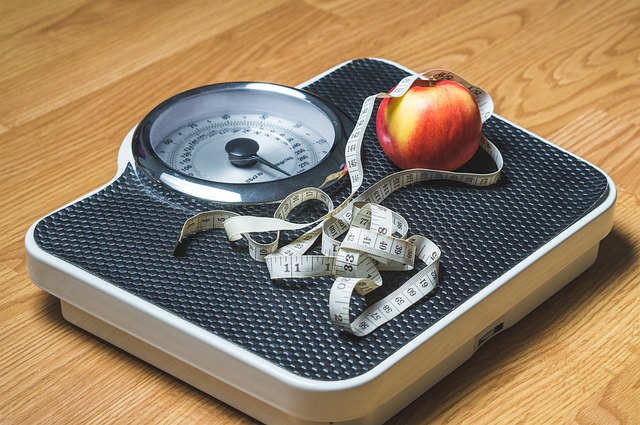
If you are fearful of regaining your hard-lost weight, this article will help you understand why maintaining lost weight takes effort. Paul MacLean, PhD, Professor of Medicine & Pathology at the University of Colorado School of Medicine, has carefully studied weight regain. He notes three reasons why dieters regain weight: biology, behavior, and environment.
Biology: The body has a strong biological drive to regain lost weight, as noted with increased appetite and a slowed metabolic rate. As backlash from dieting, the body learns to store fuel very efficiently as fat.
Behavior: After three to nine months, dieters tend to be less strict with their low-calorie diets; they often report they have hit a weight plateau. Despite self-reported claims they are diligently dieting (yet only maintaining weight), these dieters can become discouraged and less adherent. (Note: Diligently dieting anecdotes are hard to verify.)
Environment: We live in an obesogenic environment with easy access to ultra-processed foods, a sedentary lifestyle, and chemicals that contribute to weight gain including those found in upholstered furniture, pesticides, cosmetics, and who knows where else. Weight is far more complex than self-induced over-eating and under-exercising!
When adding on exercise, some people lose weight and some gain weight. Exercise alone does not guarantee fat loss. Exercisers who lose weight tend to keep the weight off if they stick with their exercise program. High levels of exercise are linked with greater success. That’s good news for athletes who train regularly! That said, a fine line exists between compulsive exercisers (who exercise to burn off calories) and athletes (who train to improve their performance). Fear of weight gain can impact both groups.
Questions arise:
Finding answers to these questions is hard to do in humans because of biology, behaviors, and environment. So MacLean turned to studying formerly obese rodents who had lost weight by being put “on a diet” and then were allowed to eat as desired for 8 weeks. Some weight-reduced rodents stayed sedentary while others got exercised.
When followed over time, the longer the rodents were weight-reduced, the stronger their appetites and drive to eat got. When allowed to eat as desired, they quickly regained the weight. “At least people, as compared to rodents, can be taught to change their eating behaviors to help counter those biological pressures,” noted MacLean. For example, people who have lost weight can stop buying fried foods, store snacks out of sight, limit restaurant eating, etc.
More depressing news. Most of MacLean’s data is from reduced-obese male rodents. Exercised males showed less weight regain than did exercised females. The female rodents seemed to know they needed extra energy to exercise, so they ate more and regained weight. MacLean states we need more research to understand the clear differences in the biological drive to regain weight.
The best way to maintain weight is to not gain it in the first place. Yes, easier said than done (as stated upfront), but at least athletic people who maintain a consistent exercise program can curb weight regain. We can also change our behaviors to minimize weight regain by prioritizing sleep, curbing mindless eating, and choosing minimally processed foods.
Ideally, the sports culture will change so that athletes can focus less on weight and more on performance. It’s time to acknowledge that athletes, like dogs, come in many sizes and shapes. Some athletes are like St. Bernards, others are like Greyhounds. A starved St. Bernard does not become a Greyhound, but rather a miserable St. Bernard.
By fueling your genetic body type and focusing on how well you can perform, you can enjoy being stronger, more powerful—and likely can still meet your sports goals. When being leaner comes with a life-long sentence to Food & Exercise Jail, you might want to think again?
Nancy Clark MS RD CSSD counsels both fitness exercisers and competitive athletes in the Boston-area (Newton; 617-795-1875). Her best-selling Sports Nutrition Guidebook is a popular resource, as is her online workshop. Visit NancyClarkRD.com for more info.
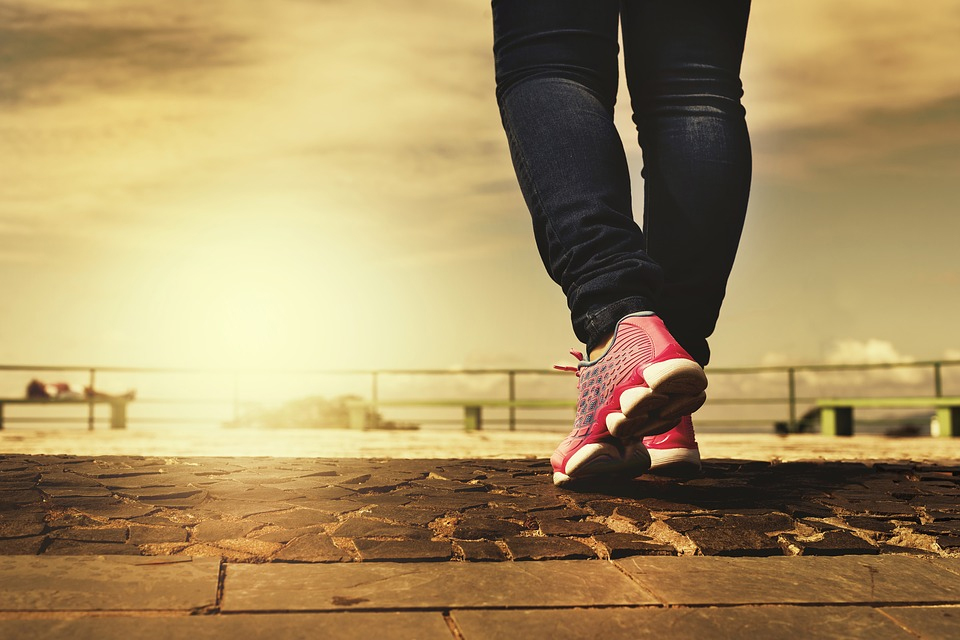
As fitness professionals, what we can expect is the unexpected. Often the last person we think may send an inquiry, does. If you’re like me and the majority of your training is in-home, you often get the privilege to work with so many you may not otherwise in a traditional gym or studio setting.

While I was used to receiving various inquiries from those with different chronic conditions or disease, disabilities and other limiting factors, the one I didn’t anticipate was a blind client. The first thing I did before responding was see what trainers in my area may be willing to work with this individual, no response, no one was interested. My first thought was my “scope of practice”. Surely this wasn’t in that category for me. While I took time to reflect on how I could possibly help this person, I did some asking around to a well-respected fitness professional not in my area. I asked him, “How do you train a blind person?” He responded by saying, “I have never had the chance to do that but I would say you train him just like anyone else.” That made complete sense to me in that moment. What I didn’t know I would research. Next, I would fully disclose that I did not have prior experience with training a blind person, but I would be happy to take him on. So, I did.
In researching training the blind community and speaking with a few people in various agencies, I couldn’t get much beyond the science and statistics. No methods, no accommodations, no modifications, no advice, not much to guide me. I did learn about Orientation and Mobility Specialists and while that was needed in the beginning for my client, it was not needed for him to have at the time for the training to take place.
You adjust everything you know about training. A huge eye opener for me was learning that I had a vision dependency on cueing. My verbal cueing was subpar. Too often I was used to saying, “Watch me first, then you try,” then correcting form as needed. In programming for my client, I needed to better learn to be descriptive so that what he could not see, he could imagine in the mind. It had to make sense.
What helped me to make progress, not just with my blind client but in general, was to really read the descriptions of exercise, movement and anatomy. Even if I had to read it continuously to better explain, that is what I did. When something didn’t make sense, we just eliminated it and found a better option.
Learning to count steps was another big deal. It was critical to know how to express inches, feet, yards when walking or moving around. For example, we are 2 yards from your driveway, in 2 feet there is a table, it is 35 steps to your mailbox.
Blindfold yourself. Close your eyes when exercising. Have another trainer, family member or friend, tell you some of the exercises that you find hard to describe and learn from those examples. Get a real feel for what your client may experience. Learn how they use their cane and the types of canes (sticks). One wealth of information came to me from a blind athlete. He took time to talk to me and just reinforce how important it is for my client to be independent.
Announce what you’re doing before you do it. It’s the same with asking to touch a client, “Is it okay if I touch your elbow?” Or, “I am going to pick up these dumbbells.”
Learning to not be so protective, smothering and motherly, as was my nature as a mother of five. I was scared every moment, what if my client falls, trips, bumps into the wall, anything. I felt I had to always be on guard and with the slightest change in movement or awkward movement, I would have my arm ready to catch if I needed. Too much! It was very helpful that a few times I had another trainer in training (my husband) come along with me and he brought it to my attention. I told him, I know I can do it, but what if something happens? He said, it just will and I can’t spend every minute in protection mode. It’s not good for me or the independence of my client.
Programming always changed. There were days we just walked because that was as much as my client could handle. Cancellations due to various reasons required me to step up and not be taken advantage of as well. Adapting to all of that and being patient in what my client needed took time.
Addictions (substance abuse). While I won’t get into much depth on this topic, there were many other challenges within this area that I was exposed to and needed to refer out and gain help for. Again, it was the unexpected.
Nutrition problems. Making sure my client was eating, what and when. There were many discussions we had regarding proper nutrition. Much of it would lead back to other barriers, such a cigarettes or substance abuse. It required other professional intervention, as I am not a Registered Dietitian, but we did review general eating habits and good vs bad. Occasionally, we got it just right.
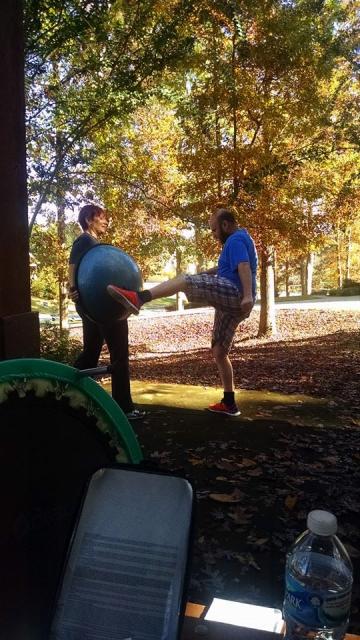
While the primary goal was weight loss and increased strength for my client, we tackled everything. We incorporated cardiovascular activities and ones we did often were running together with a rope (tether), jumping jacks, and walking. But every part of the programming goals were to incorporate functional exercises which all required flexibility, balance, core, resistance, strength training, and what my client could focus on doing alone. We used dumbbells, resistance bands, sandbells, medicine balls, jump ropes, tires, picnic table, stairs, Airex pad and simply bodyweight. The most important use of all the exercise was in how it would further benefit my client and the goals we set. Nothing should be useless training.
While there is so much more to be said on how I trained my blind client, the most important message to relay is to not be afraid of what you can’t do, but do what you can. We should always ask questions, always expand our knowledge and do what we as fitness professionals are here for — to assist in living a healthier, active lifestyle. We can’t promise the moon, but it is our responsibility to do the very best we can within our scope, and what we are hired for. If you’re doing that, than you are probably doing it well.
Dawn Baker is an Independent Contractor Personal Trainer, founder of One Accord Fitness LLC and has been changing lives in the fitness industry for 6 years.

According to the CDC (2022), about 1 in 44 children has been identified with autism spectrum disorder (ASD). Autism Spectrum Disorder (ASD) is a neurological disorder marked by deficits in social communication as well as repetitive behaviors and restricted interests (Hodges et al., 2020. This information tells us, that it is likely in the near future or even now as a fitness professional, we may experience having a client with ASD. Being a neurological disorder, there can be faulty lines between mind and body communication that influence body movements and mechanics. Therefore, as a fitness professional, working with an ASD client would require individualized programming tailored to specific needs, but there are common sensory and motor skill deficiencies we as fitness professionals can certainly assist with.

The Diagnostic and Statistical Manuel of Mental Health Disorders (DSM-5) has now coined the term “spectrum” to include both lower and higher functioning forms of autism.
The ”spectrum” consists of the following:
Furthermore, the DSM-5 requires the following for diagnosis:
Individuals must meet all the social communication/interaction criteria:
Must also meet 2 of the 4 restricted and repetitive behaviors criteria that do cause functional impairment:
There are a number of risk factors for ASD including sex because ASD is 4 times more common in boys than girls. Other risk factors include family history, age of parents when born, and being born early (CDC, 2022). The fitness professional will of course meet the ASD after diagnosis but being aware of certain behaviors and traits is an important component to help better understand and relate to the client’s needs and abilities. The fitness professional can become part of the ASD client’s comprehensive treatment program. There is a need for our help, especially since obesity rates are higher among persons with ASD. Although some of this can be related to diet, lack of physical activity is a key contributor to this phenomenon. We know that P.E. at school alone is not enough time spent moving, and because persons with ASD might need special sensory and motor accommodations, this can be a deterrent for participation. Without the advocacy of parents, activity may not be prioritized.
Common among persons with ASD, there exist vestibular, proprioception, interoception, low muscle tone, postural instability, and compromised endurance and balance deficiencies (Autism Speaks, 2022). Adding to these, persons with ASD have been found to have differences compared to those without ASD with gait (stride width, velocity, and stride length) (Autism Speaks, 2022). As fitness professionals, we have the knowledge and experience to program design for these fitness and skill related components, so having a specialization to reach this population makes us both more credible and more marketable. Special populations need special people like us to add exercise as medicine and improve quality of life, despite the challenges, stereotypes, and stigmatisms that exist when it comes to persons on the “spectrum”.
Join Megan for her webinar on this topic, Working With Special Populations: Autism Spectrum Disorder (ASD) Fitness Integration
Dr. Megan Johnson McCullough, owner of Every BODY’s Fit in Oceanside CA, is a NASM Master Trainer, AFAA group exercise instructor, and specializes in Fitness Nutrition, Weight Management, Senior Fitness, Corrective Exercise, and Drug and Alcohol Recovery. She’s also a Wellness Coach, holds an M.A. Physical Education & Health and a Ph.D in Health and Human Performance. She is a professional natural bodybuilder, fitness model, and published author.
References
Autism Speaks (2022). Autism diagnosis criteria: DSM-5.
Autism Diagnosis Criteria: DSM-5 | Autism Speaks
Centers for Disease Control and Prevention (2022). Data and Statistics on Autism Spectrum Disorder. Data & Statistics on Autism Spectrum Disorder | CDC
Hodges, H., Fealko, C., & Soares, N. (2020). Autism spectrum disorder: definition, epidemiology, causes, and clinical evaluation. Translational Pediatrics, 9(Suppl 1), S55– S65. https://doi.org/10.21037/tp.2019.09.09

“Core strength” is a popular fitness buzz term, but what’s the big deal all about? Core strength is essential for all our movements. The core is a collection of muscles that stabilizes the central muscles in our torso and spine. As our body’s center, our core has the big task of holding us upright. A strong core makes everyday activities easier to do.
You might think core training is all about lying on a yoga mat doing interminable “crunches.” But there’s way more to core training than aiming for a flat tummy or a “six-pack.”.
Importantly, you use your core when you put on shoes and when turning to look behind you. Likewise, reaching that box on your top kitchen shelf, or sitting in a chair are activities rely on a strong core. In fact, you might not notice a weak core until these activities become difficult or painful. Significantly, a strong core is also how you avoid back pain as you get older.

The key to building core strength is by employing stomach-based, diaphragmatic breaths, so that our torso and ribcage expand forward, back, and to the sides. Breathing in is bodyweight exercise that lengthens the transverse abdominis muscles and obliques, which helps build core strength. Breathing correctly can increase flexibility and lower the risk of exercise-related injury. Also, a strong core helps with things like balance, and, oh yeah… it makes you look thinner.
1.Your neck, chest, and shoulder muscles feel tight. If you carry a lot of tension in the muscles around and under your neck, those muscles may feel painful or tender. Poor diaphragmatic control can cause neck and shoulder muscles to become short and tight. Slouching means you’re not activating your diaphragm when you breathe.
2. You sigh, or yawn frequently. If you must take a deep breath, sigh, or yawn every few minutes, it’s a sign that your body isn’t getting enough oxygen when you breathe.
3. You breathe with your mouth open. Unless you have a sinus infection or congestion that prevents you from breathing through your nose, your mouth should be closed as you breathe.
4. Your resting breath rate is too fast. A normal, resting breath rate should be about 12-20 breaths per minute. If the number of times you breathe each minute is too fast, your breathing is probably shallow. A normal respiratory rate keeps the balance of oxygen and carbon dioxide even in the body.
1. Keep your shoulders still. Sit in a chair that has arms on the side. Support your arms and elbows by the arms of the chair. As you inhale through your nose, push down onto the arms of the chair. Exhale while you purse your lips and release any pressure on the arms of the chair. The purpose of this exercise is to keep you from elevating your shoulders as you inhale, which can cause upper chest breathing.
2. Slow your breath. Pursing your lips forces you breathe more slowly. Start by creating as small an opening as possible in your mouth when you breathe. Imagining you’re blowing through a straw or blowing at a candle only hard enough for it to flicker, but not blow it out. Breathe in through your nose for 2-4 seconds, then breathe out for 4-8 seconds, keeping your lips pursed. Repeat this for about 3-5 minutes.
3. Use upper chest resistance. Lie on your back, place a hand on your upper chest, apply slight downward pressure to the hard bone (your sternum) in the middle of your chest and maintain that pressure while you inhale and exhale. This will force you to “bypass” your chest while breathing and start to breathe from deep within your belly.
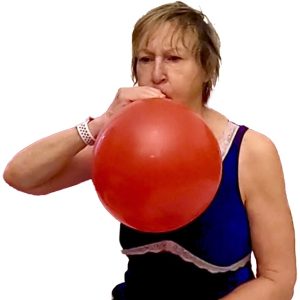
4. Blow up a balloon. When you blow up a balloon, you activate your abdominal muscles, align your spine and pelvis, and contract your diaphragm. Blowing up a balloon works your deep core muscles. It also requires all your mid-section muscles to work together. Sit on a chair with a straight back, or the floor against a wall, with your knees bent and your feet flat on the ground without leaning against the chair back or wall. Inhale deeply from your nose with your mouth closed, pushing your belly out. Then exhale by blowing slowly into the balloon, exhaling as much air as you can. Your deep abdominal muscles activate as you blow into the balloon.
Jacqueline Gikow, whose holistic, health and wellness practice centers on pain relief through better movement, is the owner of Audacious Living NYC™. She is certified through the National Association of Sports Medicine (NASM), the National Board of Medical Examiners (NBCHWC), the Functional Aging Institute (FAI), Medfit (MFN), and the Arthritis Foundation (AFAP/AFEP). Her fitness practice includes in-home and remote, one-on-one fitness training and coaching in New York City. Visit Jacqueline’s website at audaciouslivingnyc.com, or on Facebook.
References
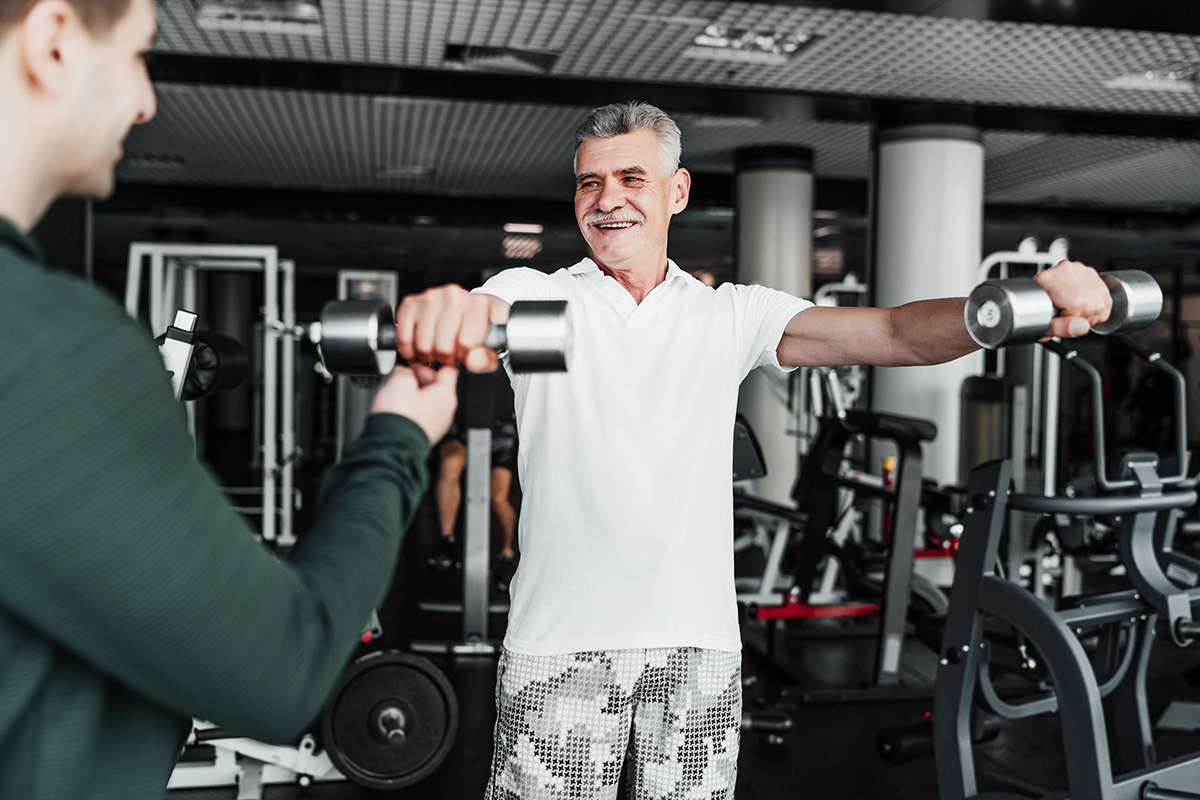
Personal Trainers, do you SPOIL your clients?
Do you keep your clients reliant on YOU?
I used to think this was a good practice. I even thought of it as Full-Service Personal Training. But in hindsight, I wasn’t teaching my clients to be responsible for their health and fitness.
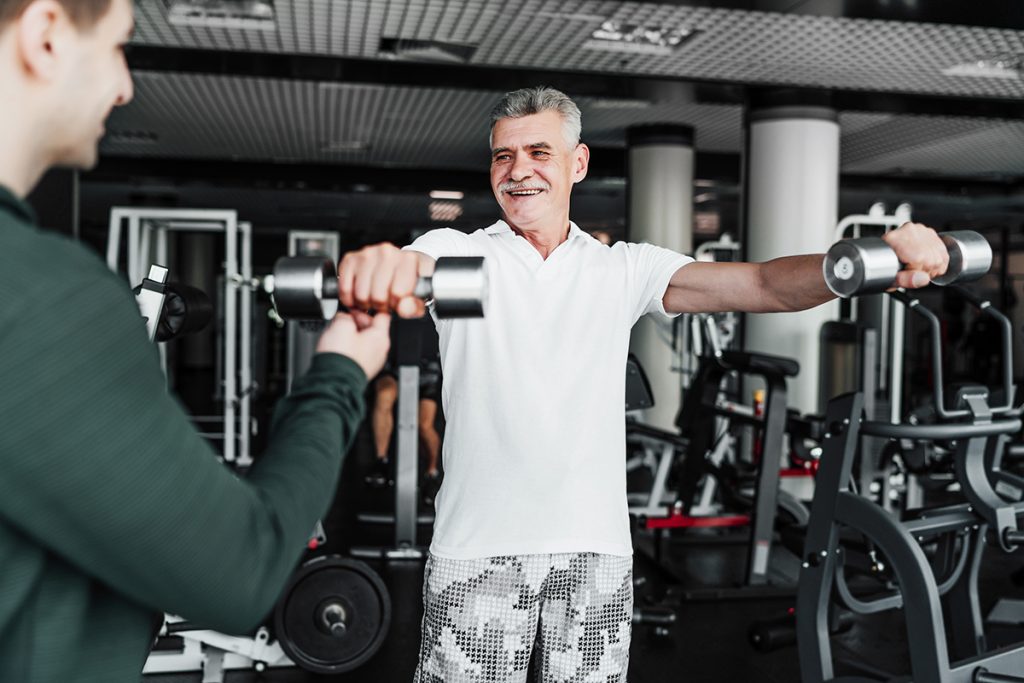
I enjoy serving my clients, bringing their dumbbells to them, taking their dumbbells, and re-stacking them. I let my clients get comfortable on the bench before giving them the bells or bar to press. I move Bosu balls and re-adjust TRX straps for my clients constantly. I have spent many hours wiping down equipment for my clients before and after use. I have adjusted weight machine bench heights, placed pins in plates, safety hooks on barbells, and the list goes on and on and on.
I thought this action was being kind and a good service provider. I am willing to bet many of you have also done this with your clients.
Flash forward 30 years in the industry. I am about to have hand surgery on my dominant hand. It is a minor surgery, but surgery non the less, and I will not be able to serve my clients in this same way while I am healing.
I have spent the last month teaching my clients how to load and de-load dumbbells safely from a bench press and how to set each weight machine for their height. Many of my clients didn’t even know how much weight they had been lifting; they just did what I said and trusted me to hand them the proper equipment.
I have spent time explaining the lengths of the TRX straps for different exercises and shown them how to adjust the straps by themselves.
This has been a big lesson for me. Doing everything for our clients only creates a client with a considerable amount of dependency on you, the trainer. This, in turn, produces less self-efficacy outside of your sessions, resulting in less progress towards their fitness and health goals.
As Professional Fitness Trainers, our ultimate goal is for our clients to be healthy. We may not always be there for them. What if you move or they move? What if you have surgery or an accident? Make sure your clients can care for their fitness with knowledge and safety.
Don’t get into the habit of full-service training. If you already have been doing it as I was, begin the de-programming process for your clients. That is the best long-term way to serve them and their health goals.
I know what some of you are thinking – if they can do it all independently, they won’t need us anymore. However, I’m afraid I must disagree. Your job is to program well and continually challenge your clients appropriately for their fitness level and health goals. If you continue to do that while educating them on the how and why of what you are doing, the sky is the limit for their success and yours! Happy Training!
Shannon Briggs is a multi-passionate fitness professional and educator. She brings 30-plus years of experience to a long, fulfilling career in the fitness industry. In the past 13 years at the University of Texas at Austin, Shannon has led continuing education workshops in multiple group fitness formats and topics specific to personal training; she also has written the curriculum and manuals for numerous workshops accredited by the American Council on Exercise (ACE). Shannon is currently a monthly contributor to Campus Rec Magazine for Fitness and Wellness.

Loss of muscle and bone mass is arguably the greatest potential threat to vitality and independence in the aging female population. As ovarian estrogen declines during the menopausal transition, muscle and bone undergo significant changes.
Muscle mass and strength decline and loss of bone density accelerates after the onset of menopause. When these losses become severe, there is an increased risk of disabling falls and fractures and associated higher rates of medical comorbidities including high blood pressure, type 2 diabetes, depression, and cardiopulmonary disease.
Previously, in Athletic Aging, I posted about this very issue. Grip Strength as a Marker of Vitality in Mid-Life Women and Body Composition and Hormone Therapy – Truth and Tales are two articles that discuss the interplay among female reproductive hormones, muscle mass and function, body composition, and metabolism.
But it’s not just about muscles and bones! Mid-life women also struggle with sleep deprivation, brain fog, depression, and mood lability.
Today we continue this important conversation and take a deep dive into the science that explores the potential benefits of creatine supplementation in mid-life women that go beyond our muscles and bones!
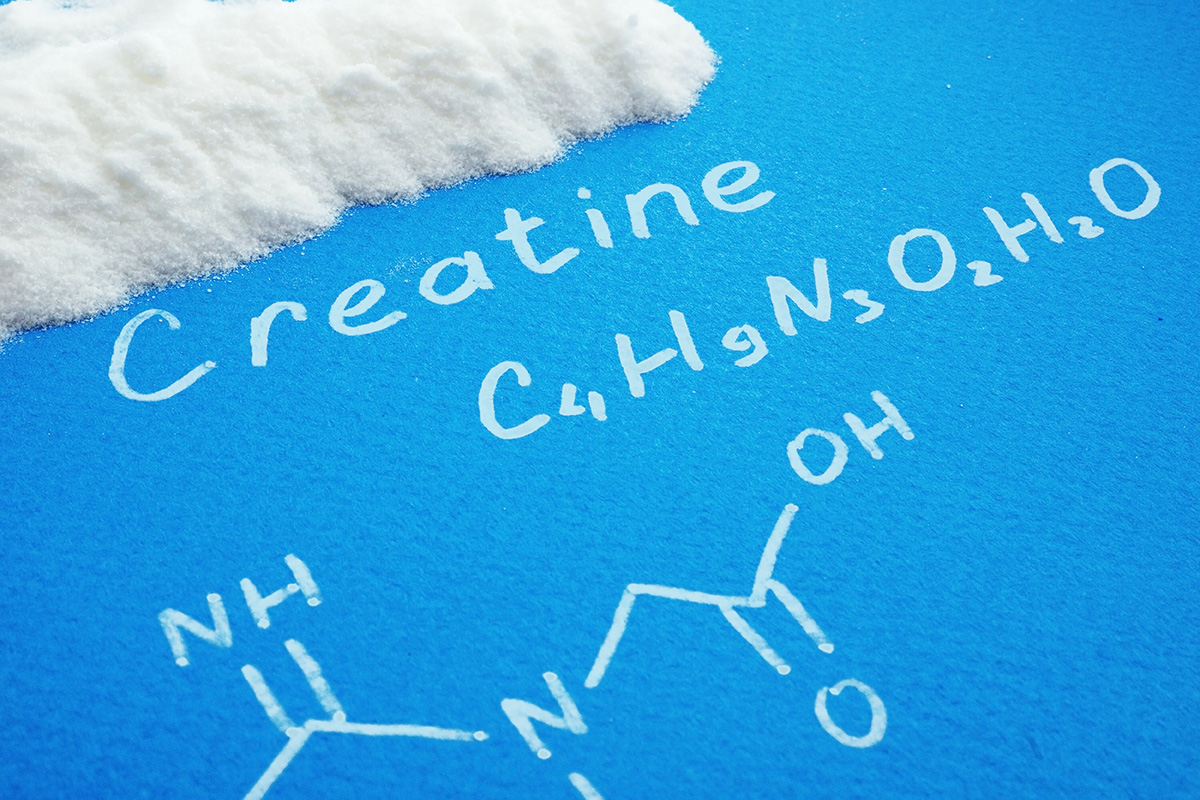
Creatine is a naturally occurring compound that is synthesized in the Human body by the kidneys and liver from the amino acids glycine and arginine. It is stored as phosphocreatine which supplies the energy that fuels muscle movement. Creatine is also found in animal proteins such as red meat, fish, poultry, and organ meats.
The phospho in phosphocreatine is a critical component for the production of adenosine tri-phosphate (ATP) found in tiny cell components called “mitochondria” that exist in every type of cell throughout the body. Think of the mitochondria as the “batteries” that power the cells within our tissues, and ATP as the “charge”. The “T” stands for tri -or 3 phosphates which is like 3 “bars” on your cell phone. When energy is used, ATP is converted to ADP – the “D” is for di- or 2 bars on your phone. So to recharge your phone to 3 bars (ATP), you need to plug it into the electrical outlet. Creatine serves as the source of energy to fully charge the mitochondria and replenish the stores of ATP.
Athletes have effectively used creatine supplementation for decades to support performance. Creatine is among the safest and most well-studied supplements in the sports industry.
Most of what we know about creatine was learned through the study of young, male athletes. Creatine has been shown to be effective in enhancing muscle strength, mass, and performance in strength-based activities. Because the aging population is particularly vulnerable to loss of muscle mass and function, attention has been turned toward investigating the potential use of creatine supplementation for preserving muscle mass and function in older individuals – particularly menopausal women.
A review of several randomized control trials and meta-analysis of studies investigating creatine supplementation in older female adults has discovered the following:
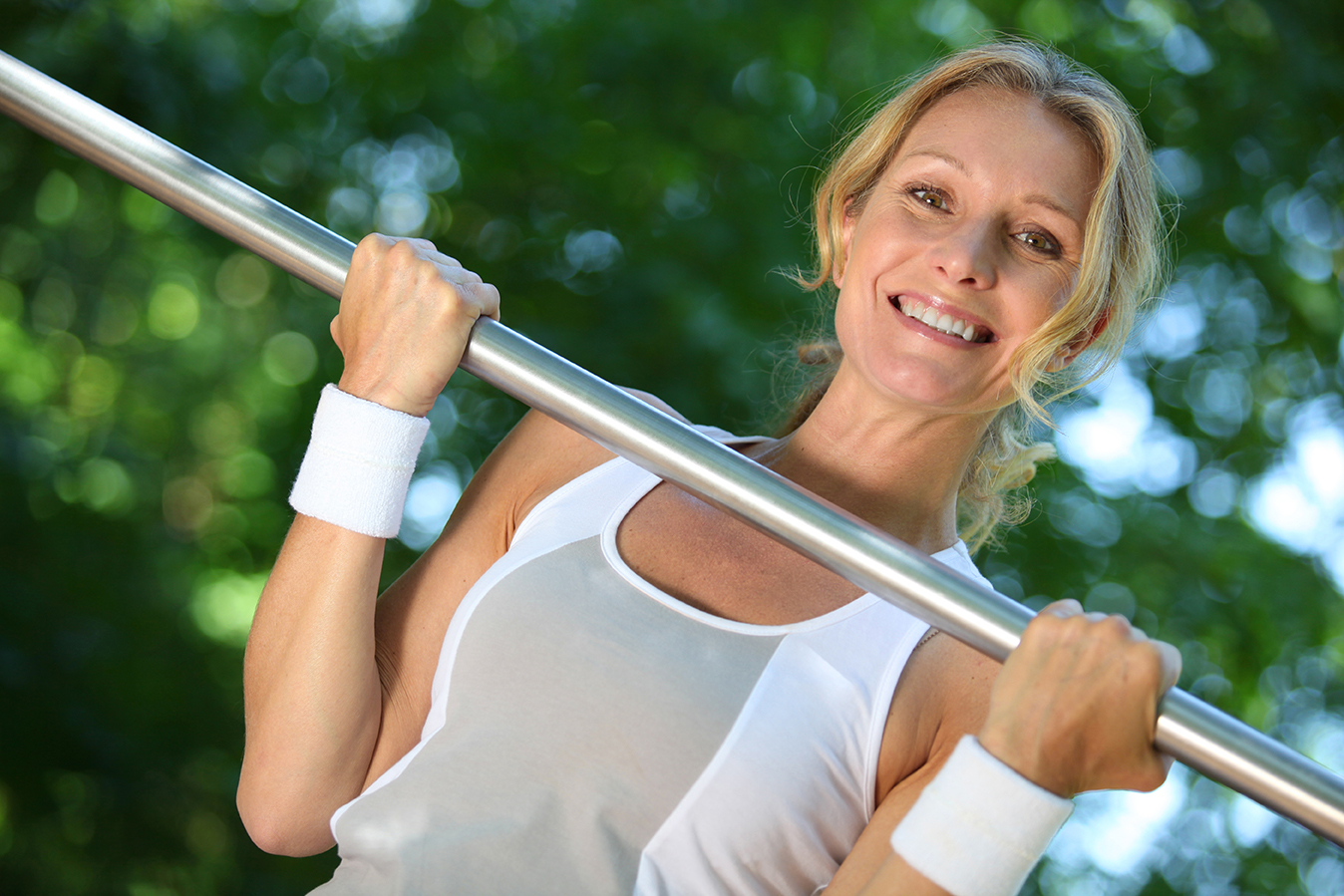
Article reprinted from Athletic Aging with author permission.
Dr. Carla DiGirolamo is a double Board-Certified Obstetrician/Gynecologist and Reproductive Endocrinologist who specializes in the care of reproductive age and mid-life women. Carla completed her residency training in Obstetrics and Gynecology at Brown University Medical School/Women and Infants’ Hospital and her Reproductive Endocrinology training at the Massachusetts General Hospital at Harvard Medical School. She is a North American Menopause Society (NAMS) Certified Menopause Practitioner and has been featured in multiple podcasts and speakerships at various events discussing the physiology of the hormonal changes of menopause, hormone therapy and functional fitness training.
References
Smith-Ryan, AE et al. Creatine Supplementation in Women’s Health: A Lifespan Perspective; Nutrients 2021, 13, 877. https://doi.org/10.3390/nu13030877Ellem
Pinheiro dos Santos, E et al. Efficacy of Creatine Supplementation Combined with Resistance Training on Muscle Strength and Muscle Mass in Older Females: A Systematic Review and Meta-Analysis; Nutrients 2021, 13, 3757. https://doi.org/10.3390/nu13113757

Because I’m a lifelong advocate of fitness walking and injury-free walking, I’m always trying to come up with the simplest way to get walkers to move along the ground in a way that produces the least amount of impact to the feet, knees, hips and lower back. The answer to this dilemma is different depending on whether you’re walking or running. I’ll begin with you walkers.
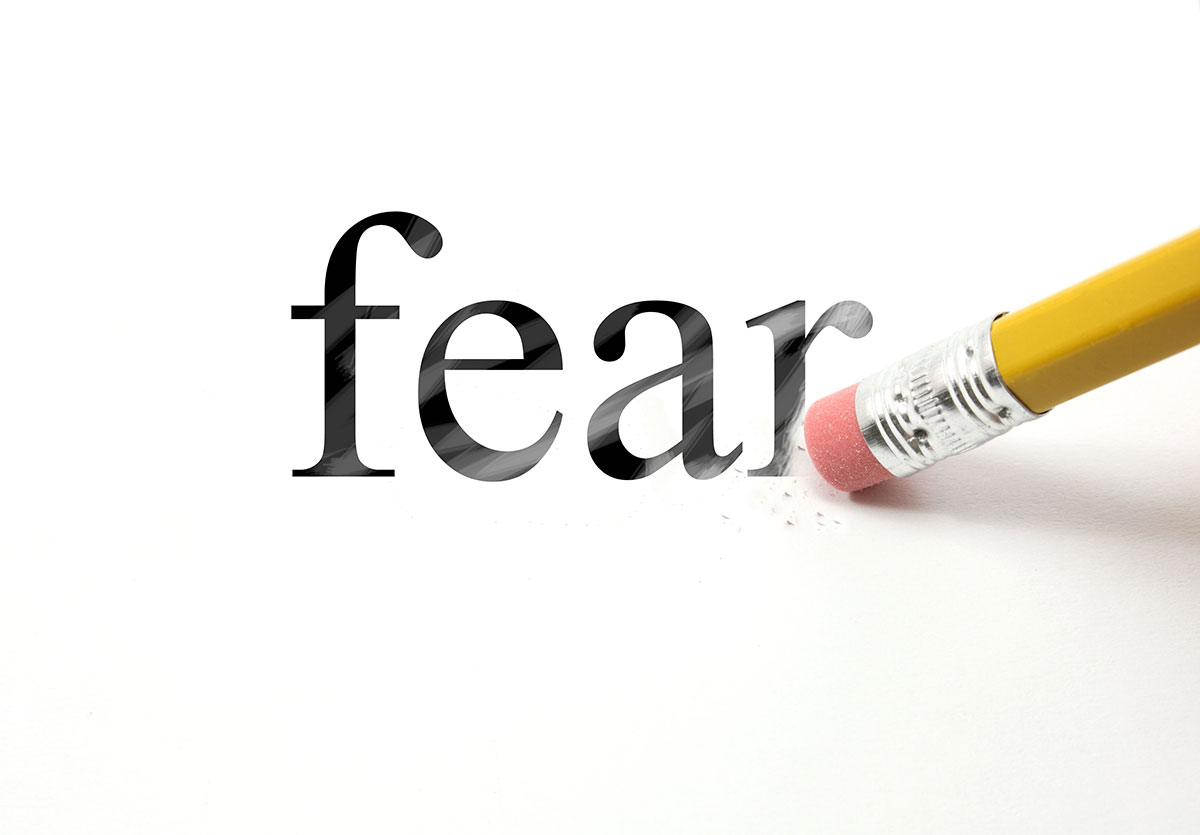
Acknowledging and accepting your fear is the first step toward limiting its power over you. Acknowledgement requires you to admit that you have fears, and acceptance requires you to realize their power. Congratulations, you are human! We all have fears, but the ways they affect our lives depends on the relationship we choose to create with them.
Once you acknowledge the existence of your fear and learn how to address it productively instead of fighting it, you reclaim some of your power over it.

As a state and federal prosecutor, I was afraid at the beginning of every trial. What if I didn’t succeed? What if I made a mistake? However, none of these fears were based on facts. By focusing on creating a positive outcome for the victim and empowering them through the trial process, I could move forward through my fear. According to Andrew Newberg, M.D., and Mark Robert Waldman in Words Can Change Your Brain: 12 Conversations Strategies to Build Trust, Resolve Conflict, and Increase Intimacy, a single positive or negative word can actually alter our brains. There is neurological power in positive thinking, so the time is now to live in the positive.
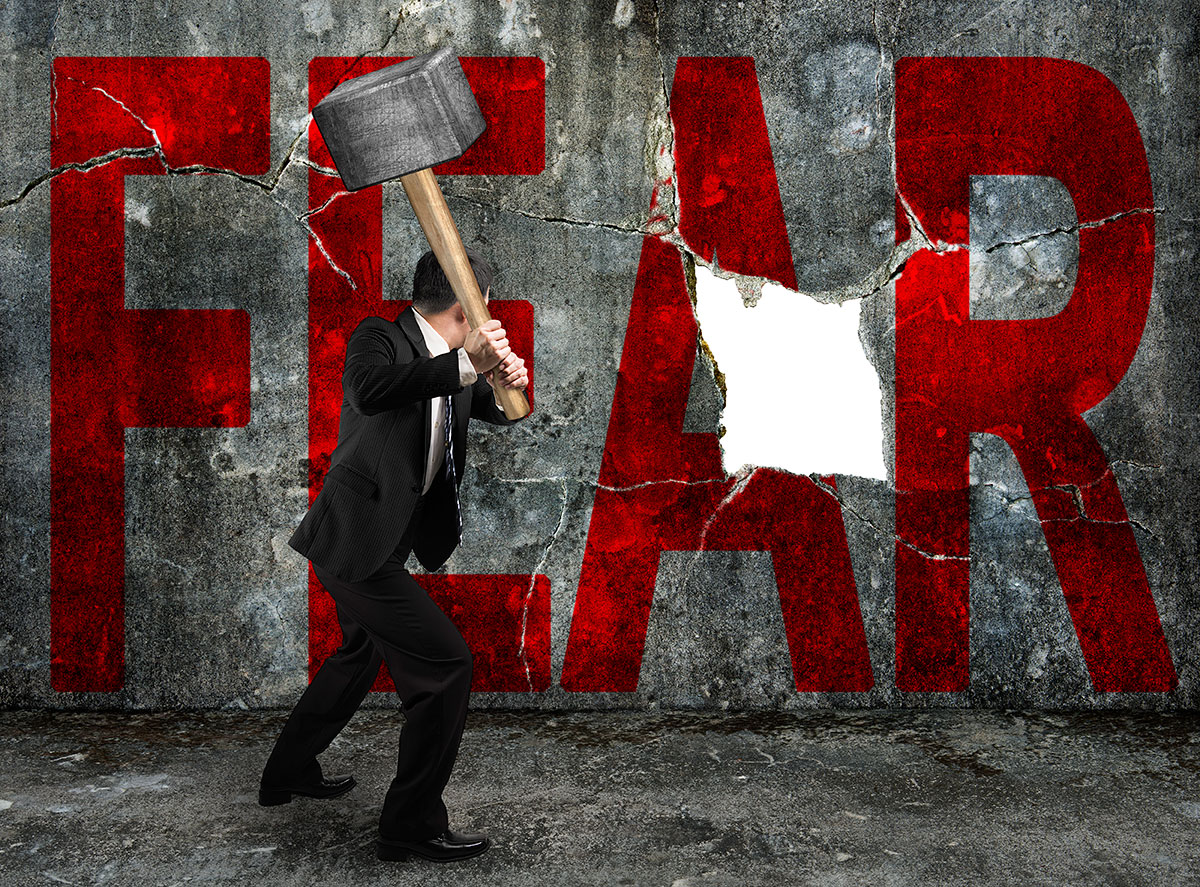
Redefine those manifestations and repeat the new definition continuously until they feel real. Repeatedly tell yourself this new positive understanding:
Visualize your success over your fear and allow the positive emotions that flow from that success to flood your body, head to toe.
Find your calm and peace the “DDB” way—engage in deep diaphragmatic breathing. At each fearful moment, use the 5-5-5-5 breathing pattern: Inhale for a count of five, hold for five, exhale for five, and repeat for five. This practice allowed me to stay present and focus on the beauty of the moment.
Reset those feelings further by recording your successes and focusing on each time you were able to feel the fear and do it anyway. I allowed every positive audition to reinforce my new positive understanding of my body’s response to each exciting opportunity. This process of transference turns negative thinking positive.
Fear is an extension of ourselves. It moves us. It represents a chance for a beautiful life transition. Fear offers an opportunity for immense growth and introduces us to new and wonderful challenges. It can be a gateway to the most beautiful, exciting opportunities, helping you to unleash talents and unearth new passions.
By taking the preceding steps, you are able to tame your fears. Remember, fear is not a villain, so there is no need for an epic battle. Instead, fear requires a relationship with yourself. It is a welcomed companion, a catalyst for change to constantly challenge your status quo. So, the next time you feel fear, ask, “What opportunity lies on the other side?” Challenge yourself to live through it. Do what makes you shake! Do what makes you shy away! It may not be easy, but it’s essential for continued breakthrough as you journey to your highest state of excellence.
When you’re willing to feel the fear and move forward anyway, you position yourself to truly write your story, live your purpose, elevate your thoughts, visualize your success, and live a life without regret and with passion, laughter, self-determination, and endless optimism.
Lisa Charles is a federal prosecutor turned singer/actress, wellness expert, certified health coach/consultant, and an acclaimed speaker. She served as the Fitness/Wellness Research Coordinator for the Rutgers University Aging & Brain Health Alliance, and is the CEO of Embrace Your Fitness, LLC, and the Author of YES! COMMIT. DO. LIVE.